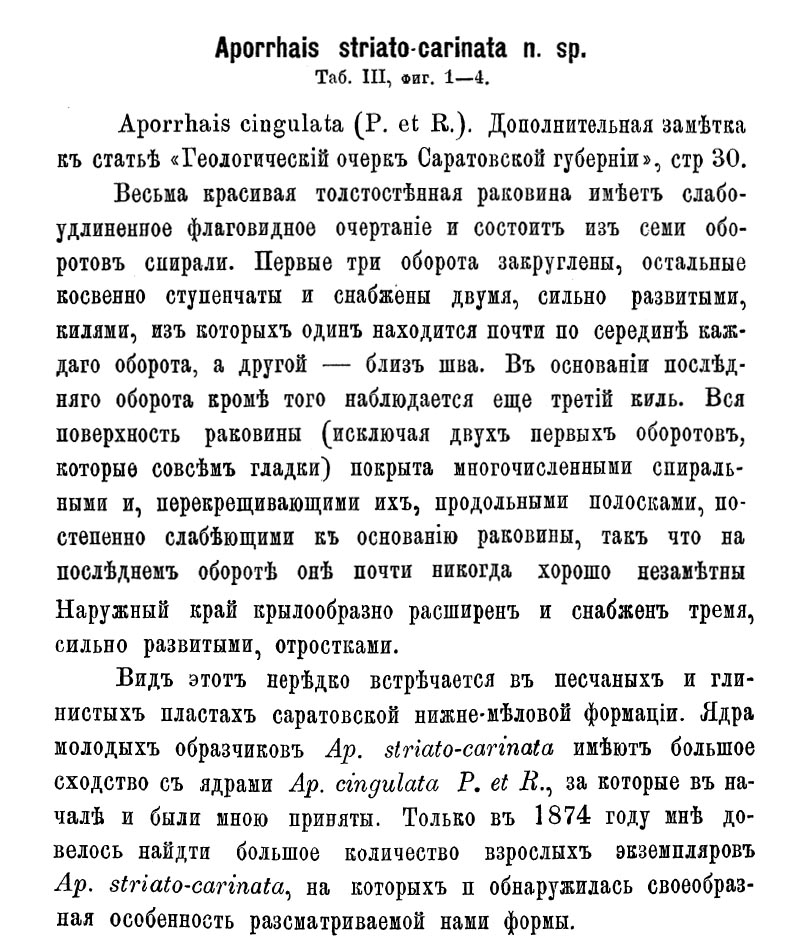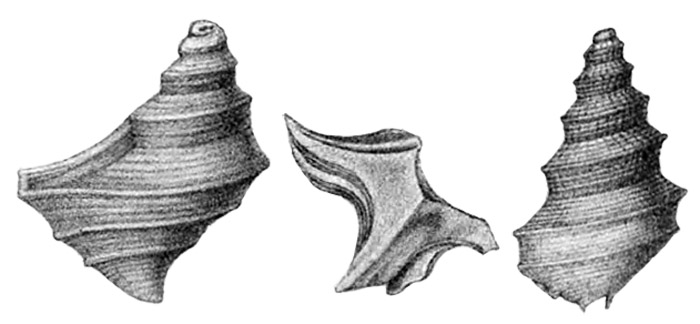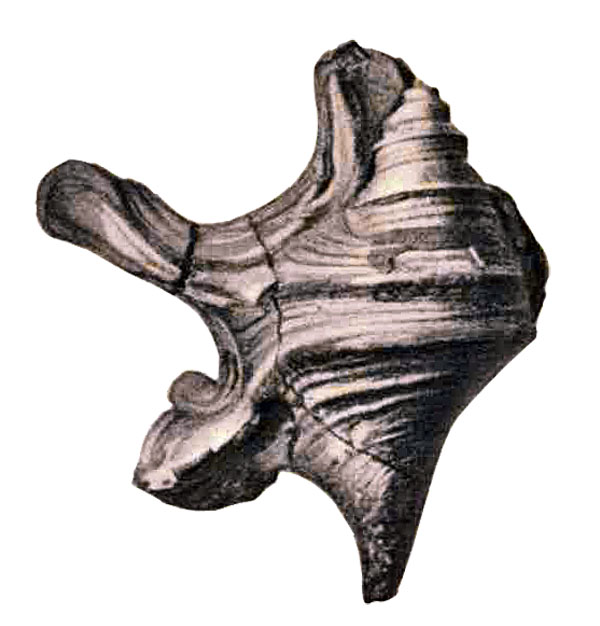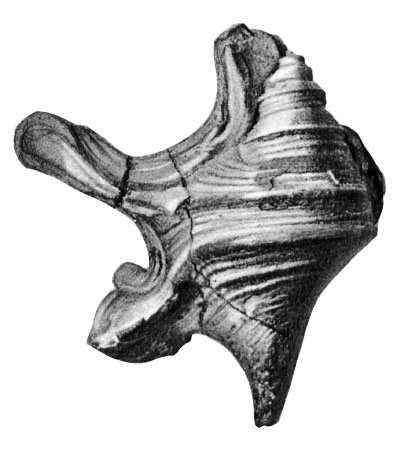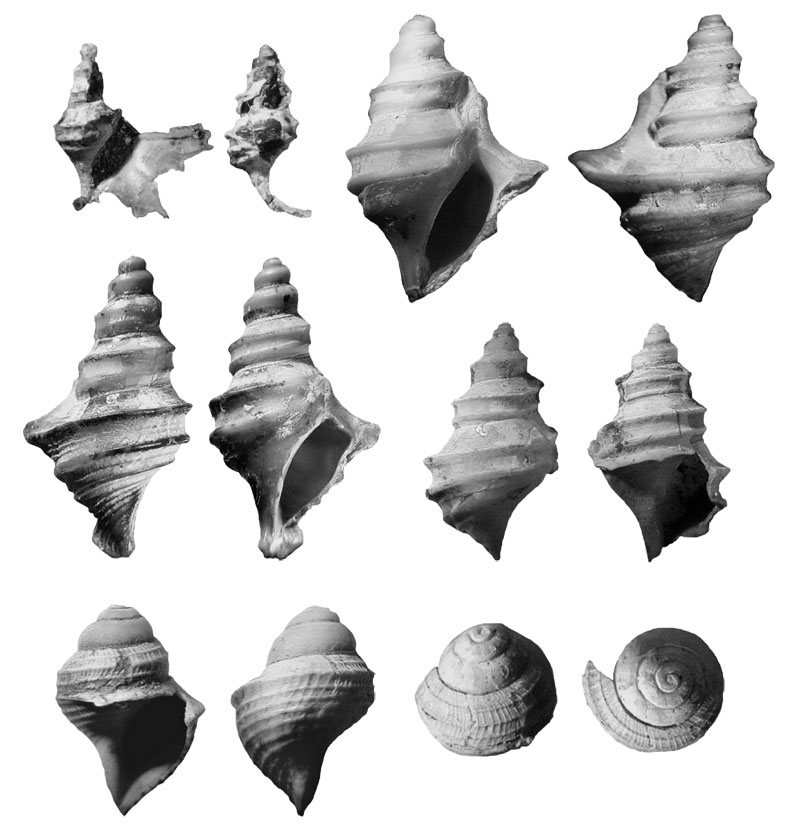Species / Trilemma Striatocarinatum
Stromboidea
Original Text on Aporrhais striato-carinata by Sinzow, 1880, p. 6/7:
transliteration and translation needed
Aporrhais striato-carinato Sinzow, 1880, pl. III, fig. 1, 2, 3
History and Synonymy
1908
Aporrhais bicarinata in Wollemann, 1908, pl. 13, fig. 12
- Moorhütte, Germany; "Oberneocom" = Barremian
In text: Aporrhais (Tessarolax) bicarinata Deshayes
Comment Wollemann, 1908: "... Besonders schwankend ist die Gestalt der Finger; bald sind dieselben schmal und lang, wie bei meinem Original von der Moorhütte (Wollemann, 1900), bald sind sie kürzer und breiter. Besonders interessant ist das jetzt abgebildete, fast vollständige Stück, welches ich Herrn Prof. STOLLEY verdanke. Die beiden unteren Finger endigen hier mit einem kurzen Wulst, die Innenlippe ist stark entwickelt und bildet auf dem Gehäuse bei ihrer Umbiegung ebenfalls einen Wulst. Jedenfalls rührt dieses Gehäuse von einem alten, ausgewachsenen Individuum her...."
1912
Aporrhais bicarinata in Wollemann, 1912, pl. 13, fig. 12
2006
Blagovetshenskiy & Shumilkin, 2006 define Trilemma and have chosen Aporrhais striato-carinata as type species.
Description of Trilemma striatocarinatum (Sinzow, 1880) by Blagovetshenskiy & Shumilkin, 2006:
- "The shell is of medium size, fusiform, with a wing like extension of the palatal margin of the aperture, and consists of seven or eight predominantly bicarinate whorls. The upper carina is located just above the mid-whorl of the spire, the lower carina runs above the abapical suture. Both carinae are approximately equally developed and are shaped like rollers. In adult individuals a third carina, which is of slightly smaller size, appears at the base of the last whorl under the second carina. On the last whorl the interspaces between the carinae are of approximately equal size. The surface of whorls is concave between the carinae and becomes concave to almost flat and inclined at 40°–50°to the axis of the shell above the upper carina. The height of each spire whorl is 1.4–1.7 of the preceding. The ratio of the width of the last whorl measured above the aperture to the height of the last whorl above the aperture is 2.0–2.1 in adult individuals and 2.9 in young individuals. The apical angle is 80°–90°. The generating line is slightly convex. The protoconch is smooth and consists of 3.5 whorls, after which the spiral and (slightly later) axial costellae appear. The boundary between the protoconch and teleoconch is arbitrarily determined by the appearance of the surface ornamentation. The fourth spire whorl bears four spiral costellae, of which the second (counting from the adapical suture) is slightly larger than the others and passes into the upper carina on the fifth whorl. In adult individuals with a well-developed winglike extension of the palatal margin of the aperture, the upper carina passes into the posterolateral process. On the fifth (or sixth) whorl, the development of the fourth (or fifth) spiral costa results in the formation of the lower carina, which extends in adult individuals over the anterolateral process. Between the upper and lower carinae, a weak spiral costella (the third, counting from the upper carina) persists. The later whorls contain additional (secondary) costellae between the carinae, the eighth whorl contains three such costellae. On the last whorl of adult individuals, the sixth (or seventh counting from the adapical suture) costa becomes more robust to make the third carina, which is less developed than the upper two, more prominent. The third carina also extends over the anterolateral process. Between the third and the two upper carinae, there is a weak spiral costella. On the last whorl of adult individuals, there are seven spiral costellae above the third carina and three spiral costellae, of which two are secondary, above the upper carina. In young individuals (which consist of five whorls), there is one spiral costella above the upper carina. The axial ornamentation appears on the fourth whorl in the form of costellae bent rightward. The angulation occurs at the level of the second (from the top downward) spiral costa (which becomes the upper carina on the later whorls). In young individuals (consisting of five whorls), the axial costae on the last whorl beneath the upper (and still single) carina are slightly bent to the left in the middle part. The axial costellae are approximately three times as narrow as the spiral costellae and are slightly lower, i.e., the ornamentation is decussate. The axial and spiral costellae cross to form a mesh in the form of a narrow parallelogram, which is aligned along the axis of the shell (ornamentation of an oblique lattice type). The axial ornamentation is clearly defined only on the fourth and fifth whorls and then becomes almost imperceptible. The aperture is oval, as viewed from the columellar margin, and angular, as viewed from the carinae. The upper palatal-parietal margin of the aperture passes into the posterior process, which coalesces with the surface of the last whorl up to the level of the upper carina, or even up to the nearest adapical spire whorl, and up to the upper carina. The posterior process is lost; however, it probably rose higher than the initial whorls of the shell. The anterior process is robust, considerably curved backwardly. The palatal margin of the aperture extends to form a winglike structure and have two narrow, triangle-shaped, approximately equally developed processes. The posterolateral process is directed horizontally rightward and, subsequently, probably turns upward. The anterolateral process is directed rightward and downward. On the apertural side, the processes have shallow notches, which correspond to the carinae on the opposite side. No complete anterior and posterior lateral processes have been preserved; however, they were probably narrow, elongated, with pointed ends. The columellar and parietal margins of the aperture have smooth bright surface of gray color. The umbilicus is absent."
Locality: Ulyanovsk, Volga Region, Russia
Stratum: Decheni zone of Ulyanovsk (Volga Region), upper Hauterivian, lower Cretaceous
Trilemma striatocarinatum (Sinzow, 1880); Decheni zone of Ulyanovsk (Volga Region), upper Hauterivian, lower Cretaceous; Polivna, Russia; Picture used with permission of Springer Earth Sciences, License Number 2497160956010; Copyright Springer Earth Sciences
Specimens height:
- First ligne: 19.7 mm - 16.3 mm
- Second ligne: 21.4 mm - 13.8 mm
- Third ligne: 3 mm
References
- Blagovetshenskiy & Shumilkin (2006)
- I. F. Sinzow, 1880, Description of Some Species of Mesozoic Fossils from the Simbirsk and Saratov Regions, Zap. Novorossiisk. O–va Estestvoispyt. (Mémoires de la Société des naturalistes de Nouvelle-Russie (Odessa)), 7 (1), 1–12, pls. 2, 3.

